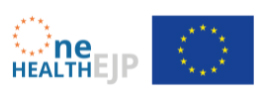ECO-HEN: Dynamics of E.coli in laying hens
Comunicación online en One Health EJP Annual Scientific Meeting
11 de abril de 2022
Aldea-Ramos I.
Antimicrobial resistance (AMR) is a top health priority under the One Health perspective since spread of AMR bacteria does not recognize borders across humans, animals and the environment.
Knowledge on transmission dynamics of AMR bacteria is a key factor for better understanding the role of animals and food of animal origin as a source of AMR bacteria in humans. Obviously, zoonotic AMR bacteria have been largely studied, especially salmonellas, but there are commensal AMR bacteria that can better spread AMR genes, being Escherichia coli one of the best carriers.
E.coli contribute to AMR spread by clonal strains able to survive on the food chain and by its ability for horizontal transfer of genetic platforms (like plasmids and integrons) containing AMR genes across bacteria. The presence of AMR E. coli in animal intestinal microbiota is well documented, especially in those animals which are under intensive production systems like pigs and broilers. Sows are, for instance, the main source of AMR E. coli populations in piglets, but their fate during the lifespan of pigs depends on different factors, especially the selective pressure imposed by antimicrobial use (AMU).
On commercial table eggs production, the dynamics of AMR E. coli populations have been scarcely studied. It is plausible that one‐day chicks represent a relevant source of AMR bacteria. However, since AMU use is very limited during the egg‐production stage due to the zero days of withdrawal period, the main selective pressure favouring persistence of AMR populations is almost absent. Thus, if there were no additional sources of AMR E. coli, those deriving from one‐day chicks should be reduced in the intestinal microbiota of hens, and thereby faecal shedding and the consequent risk of spread to the food chain (both directly through eggs and indirectly through manure used as organic fertilizer in crops) should be limited.
The main goal of this proposal is to fill the gap on the transmission dynamics of AMR E. coli in commercial laying hen production and to determine to what extent this animal production poses a public health risks via food and/or environment contamination.
The main hypotheses are: a) one‐day chicks are an outstanding source of AMR E. coli in commercial eggs production, and b) limited or no use of antimicrobials reduces the possibilities of AMR E. coli transmission to the food chain and to the environment.
The following methods are proposed:
Monitoring of four batches of commercial laying hens farms from one day‐old chicks to laying hens (rearing period and production cycle), including both animals and table eggs.
Detection of E. coli populations, using antibiotic‐supplemented (cefotaxime and ciprofloxacin) and non‐supplemented culture media.
E. coli identification and characterisation by PCR and MALDI‐TOF (10 isolates per culture media and sampling).
E. coli phenotypic characterisation of AMR by broth microdilution.
E. coli genotypic characterisation using Whole Genome Sequencing.
The obtained knowledge will reveal to what extent the table egg production system represents a risk for spread of AMR to humans and the environment as genomic data will be shared across electronic platforms and will be available for a larger community of clinical and environment microbiologists for comparative analyses. Furthermore, the results will also reveal what the effect is of reduced antimicrobial use in the production animals on the AMR bacteria initially present in the one‐day chicks

|
 | Servicio de Zoonosis de Transmisión Alimentaria y Resistencia a Antimicrobianos (ZTA). Centro de Vigilancia Sanitaria Veterinaria (VISAVET). Universidad Complutense (UCM). |
 | Departamento de Sanidad Animal. Facultad de Veterinaria. Universidad Complutense (UCM). |
Enlace a One Health EJP Annual Scientific Meeting


